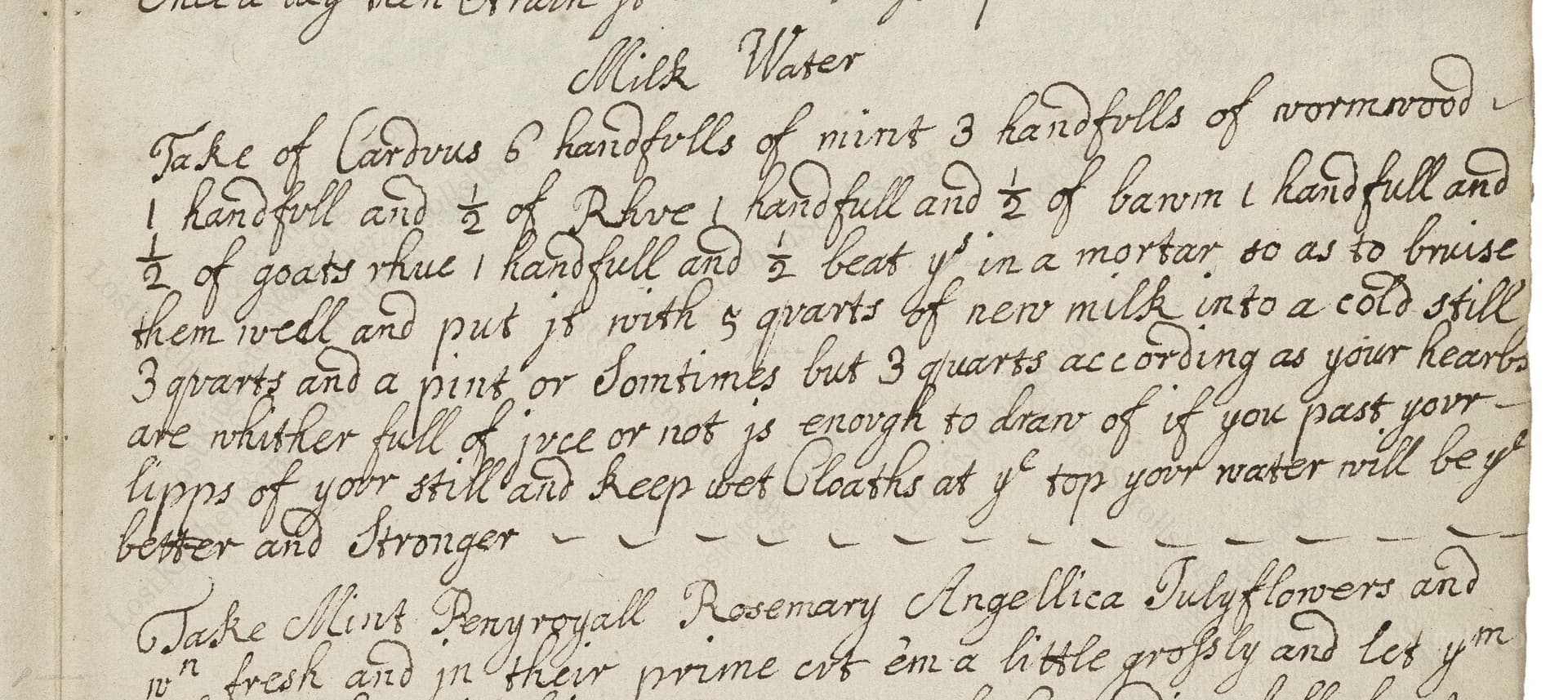Milk Water
From the treasured pages of Cookbook of Mary Cruso and Timothy Cruso
Written by Mary Cruso

Milk Water
"Take of Carduus 6 handfulls of mint 3 handfulls of wormwood 1 handfull and 1/2 of Rhue 1 handfull and 1/2 of bawm 1 handfull and 1/2 of goats rhue 1 handfull and 1/2 beat ym in a mortar so as to bruise them well and put it with 5 quarts of new milk into a cold still 3 quarts and a pint, or sometimes but 3 quarts according as your hearbs are whether full of jyce or not is enough to draw of if you pass your lipps of your still and keep wet cloaths at ye top your water will be ye better and stronger -"
Note on the Original Text
Instructions are presented in flowing prose with ambiguous measurements—‘handfuls’ and ‘quarts’—and without standard temperatures. Early modern recipes often assumed the reader’s familiarity with herb gardens and household tools. The directions reflect practical kitchen knowledge, with spelling like 'hearbs' (herbs), 'ye' (the), and 'ym' (them) common for the late 17th century. The focus is on process and judgement—adjust the milk based on juiciness of herbs—rather than strict measurement.

Title
Cookbook of Mary Cruso and Timothy Cruso (1689)
You can also click the book image above to peruse the original tome
Writer
Mary Cruso
Era
1689
Publisher
Unknown
Background
Step into the flavorful world of 17th-century cuisine with Mary Cruso’s delightful collection, where time-honored recipes and inventive cookery tips offer a peek at the tastes and talents of yesteryear’s domestic kitchens.
Kindly made available by
Folger Shakespeare Library
This recipe comes from Mary Cruso, dating to 1689, a time when household distillation was a blend of medicine and culinary experimentation. 'Milk Water' was likely consumed not as a beverage, but as a medicinal tonic—believed to soothe, settle the stomach, or treat various ailments due to the believed properties of its potent herbs and dairy base. Recipes like this were common in early modern Britain, particularly among gentry and the aspiring middle classes. Women's manuscripts such as Cruso’s reveal how the kitchen was also an apothecary, blending cookery and home remedies with ingenuity and local ingredients.

The key tool here is a 'cold still', a type of simple home distillation apparatus made from copper or pewter, designed for extracting aromatic waters and tinctures without direct heat. A mortar and pestle was essential for bruising the herbs so their juices would release into the milk during distillation. Cloths soaked in cold water were draped around the top of the still to increase condensation and help collect the distillate more effectively.
Prep Time
30 mins
Cook Time
3 hrs
Servings
16
We've done our best to adapt this historical recipe for modern kitchens, but some details may still need refinement. We warmly welcome feedback from fellow cooks and culinary historians — your insights support the entire community!
Ingredients
- 4.2 oz fresh Carduus (Blessed Thistle or Milk Thistle)
- 2.1 oz fresh mint leaves
- 1.1 oz fresh wormwood
- 1.4 oz fresh rue (substitute: very small amount of celery leaf or omit if unavailable)
- 1.4 oz fresh lemon balm
- 1.4 oz fresh 'goat's rue' (Galega officinalis, substitute: fenugreek greens)
- 1.3 gallons whole, unpasteurized milk (use highest fat content milk available)
Instructions
- To recreate this centuries-old 'Milk Water' in a modern kitchen, gather 4.2 oz fresh Carduus (Blessed Thistle or Milk Thistle), 2.1 oz fresh mint, 1.1 oz fresh wormwood, 1.4 oz fresh rue, 1.4 oz fresh lemon balm, and 1.4 oz fresh 'goat's rue' (Galega officinalis; substitute with fenugreek greens if unavailable).
- Bruise all fresh herbs thoroughly in a mortar and pestle.
- Combine the herbs with 1.3 gallons of whole, unpasteurized (ideally raw) milk.
- Place this mixture into a large still or a nonreactive pot suited for gentle distillation.
- Adjust the quantity of milk down to 0.92–0.99 gallons if your herbs are particularly juicy.
- Begin a cold distillation process, ensuring the lid of your still remains cool and is draped with damp cloths to encourage condensation.
- Collect the distilled 'water' until the liquid becomes faintly flavored.
- Bottle and store in sterilized glass.
- Enjoy medicinally or as a unique herbal cordial.
Estimated Calories
15 per serving
Cooking Estimates
This recipe takes some time to prepare and distill. You will need to bruise all the herbs, mix them with milk, and then distill the mixture. The process is slow, but most of the time is hands-off as the distillation happens. Each serving is low in calories, since the liquid is mostly water vapor from milk and herbs, and little fat or sugar carries over.
As noted above, we have made our best effort to translate and adapt this historical recipe for modern kitchens, taking into account ingredients nowadays, cooking techniques, measurements, and so on. However, historical recipes often contain assumptions that require interpretation.
We'd love for anyone to help improve these adaptations. Community contributions are highly welcome. If you have suggestions, corrections, or cooking tips based on your experience with this recipe, please share them below.
Join the Discussion
Rate This Recipe
Dietary Preference
Main Ingredients
Culinary Technique
Occasions

Den Bockfisch In Einer Fleisch Suppen Zu Kochen
This recipe hails from a German manuscript cookbook compiled in 1696, a time whe...

Die Grieß Nudlen Zumachen
This recipe comes from a rather mysterious manuscript cookbook, penned anonymous...

Ein Boudain
This recipe comes from an anonymous German-language manuscript cookbook from 169...

Ein Gesaltzen Citroni
This recipe, dating from 1696, comes from an extensive anonymous German cookbook...
Browse our complete collection of time-honored recipes



